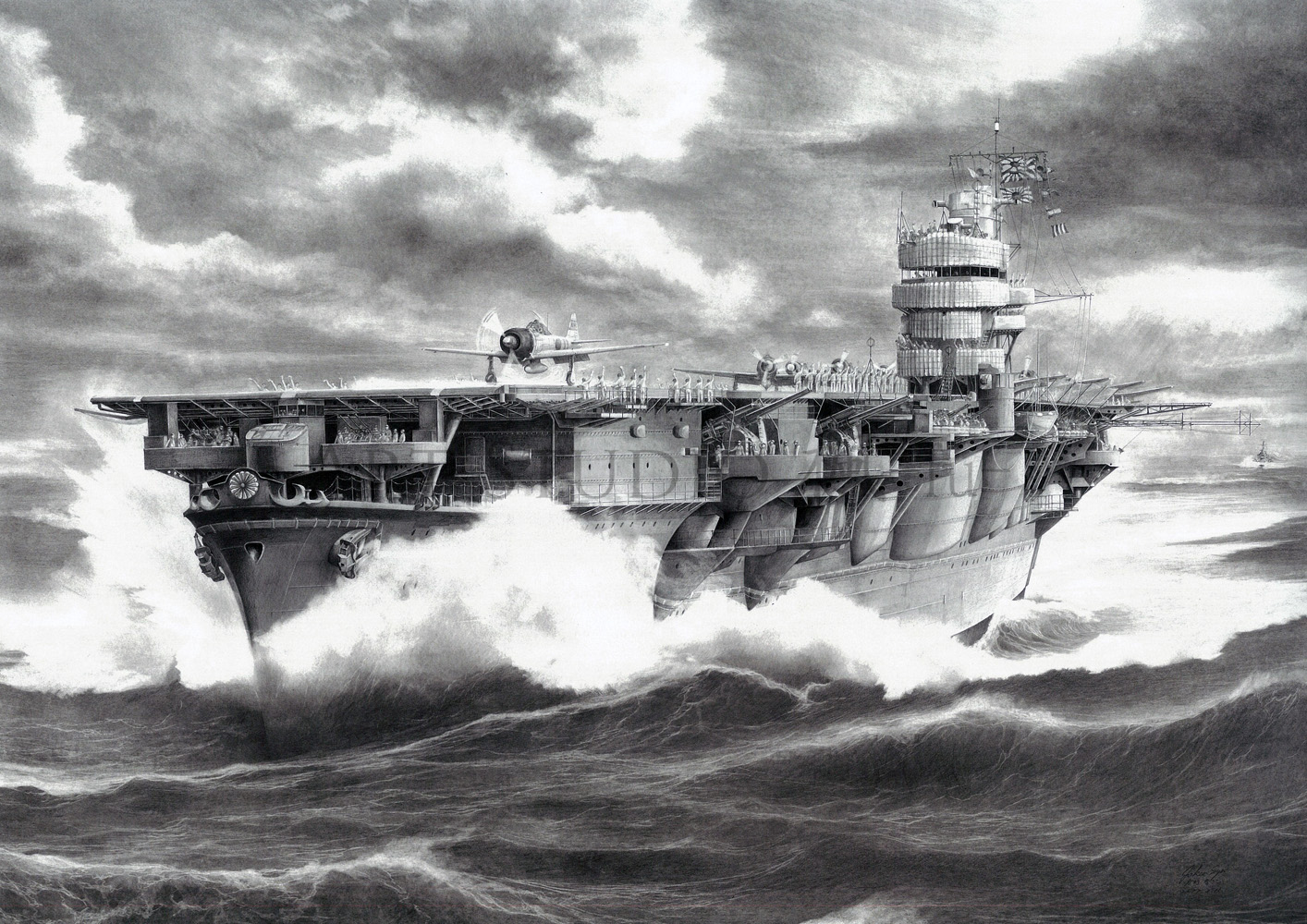蒼龍と飛龍は、②計画(第二次補充計画)で計画・建造された中型空母です。軍縮条約の制限下で建造された蒼龍と、制限を受けずに、より理想的に建造された飛龍の2隻は、先行艦の赤城、加賀と共に空母戦力の増強に大いに貢献しました。大東亜戦争の序盤は、揃って主要な作戦に参加しました。
「龍は激浪を越えて」は、蒼龍、飛龍の2隻を主題として描いた、阿吽の対となった作品です。蒼龍は波を乗り越え艦底を露わにした構図から「阿形」とし、対する飛龍は波に艦首を突っ込んだ構図から「吽形」と見立てています。その一方で、それぞれの作品は異なるコンセプトで制作しています。蒼龍の方は、背景の空に2匹の降り龍が隠れており、艦首を上に向ける蒼龍を昇り竜に見立てた、龍図になっています。また飛龍はミッドウェイ海戦の武勲誉ある艦でもあり、艦載機が発艦する最も空母らしいと思える場面を描きました。
Dragons conquer the raging waves
“Hiryu and Soryu”
The Hiryu and Soryu were built as medium-class carriers as part of the Second Replenishment Plan. The Soryu was built according to the restrictions of the Naval Treaty, but the Hiryu’s construction circumvented those restrictions.
These two ships, along with the Akagi and Kaga, greatly increased Japan’s carrier force. In the beginning of the Greater East Asian War (the Pacific War) these ships played a significant role.
“Dragons conquer the raging waves” features both these ships, and shows their power. The Soryu is cresting a large wave, while the Hiryu is plowing through one. These works have two different concepts. With Soryu, two dragons can be seen descending from Heaven in the background clouds. With the Hiryu, who upheld the honor of the Nation at the Battle of Midway, she is performing what carriers do in war, launching aircraft.
蒼龍は、大日本帝国海軍が②計画(第二次補充計画)で建造した中型空母です。軍縮条約による制限を受けた上、建造中に第四艦隊事件(※)が起きたことで、強度確認のために艦体を輪切りにする大工事が行われるなど、幾度もの計画変更に見舞われ、その建造は多くの困難を伴いました。
大東亜戦争開戦以降、大日本帝国海軍の主力空母の1隻として真珠湾攻撃に参加し、以後も主要な作戦に従事しました。昭和17(1942)年6月5日、日本時間午前7時25分頃、アメリカ空母ヨークタウン所属SBDドーントレス急降下爆撃機十数機の攻撃を受け被弾し、大火災となりました。艦は柳本艦長以下700余名を抱き、日没とともにミッドウェイ沖の海面から姿を消しました。
※艦艇の強度不足が問題視され、大幅な設計の見直しが行われるきっかけとなった、大規模海難事故
Aircraft carrier HIJMS Soryu
“Dragons conquer the raging waves-Aircraft carrier HIJMS Soryu-”
Soryu was a medium-class carrier built under the Second Replenishment Plan. She was built under the stipulations of the Washington Naval Treaty, but while under construction, the Fourth Fleet incident* occurred, so many tolerance tests were taken on her hull to confirm its strength. These tests, along with changes in plans, made construction complicated.
In the Greater East Asian War (the Pacific War), she was one of the main carriers of the Imperial Japanese Navy, and participated in the Pearl Harbor attack. On June 5, Showa 17 (1942), at 7:25 a.m. Japan time, she was caught by some 20 or more SBD Dauntless dive bombers from the American carrier Yorktown, and set aflame.
Along with Captain Yanagimoto and 700 of her crew, she did not survive the day, and disappeared beneath the sea.
*Hulls were found to be of insufficient strength, and many changes were made to their design.










